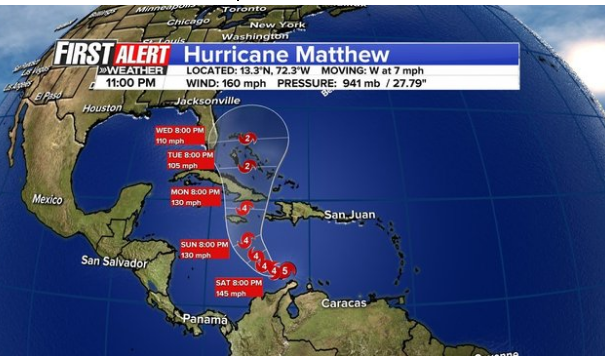Hurricane Matthew Makes Landfall
October 11, 2016
On Monday, October 3rd, the Category 4 Hurricane Matthew made contact with its first victims Haiti and Cuba. The tropical storm marked “extremely dangerous” was the last thing the country still recovering from a devastating earthquake and a cholera outbreak needed.
On October 4th, the hurricane made landfall bringing 125 mph winds and an estimated 40 inches of water in precipitation, which consequentially led to flash-floods and mudslides. The harsh weather flattened homes, flooded villages, razed crops, swept away cattle, and cut off parts of the island from each other.
Since Matthew made landfall, the death toll in Haiti alone had risen to 336 as of a few days ago, according to Joseph Edgard Celestin, a spokesman for Haiti’s Civil Protection Service; although other sources predict numbers in the 900s and 1000s more recently. In addition, Celestin told CNN, “Four people are missing, 211 are injured and more than 60,000 people are now displaced from the killer storm.”
Furthermore, the effects of Hurricane Matthew on Haiti are expected to continue even after it passed. Numerous sources say the aftermath of the storm could worsen the country’s cholera epidemic, which is responsible for about 10,00 deaths ensuing the earthquake of 2010. UNICEF estimates about 500,000 children live in the areas in the southern region of Haiti most affected by the hurricane.
After Haiti, Hurricane Matthew proceeded to parts of the Bahamas from October 5th to 6th as both a Category 3 and Category 4 hurricane. Although the storm picked up winds of up to 140 mph, residents of the areas were relieved as the hurricane appeared to have spared the areas of the high death toll it brought other countries. Hence, no deaths or serious injuries have been reported from the Bahamas as of yet.
After making its way past the Bahamas, Hurricane Matthew regressed into a Category 1 hurricane, and moved very close to the coast of the southeast United States, affecting Florida, Georgia, South Carolina, and North Carolina. On October 7th, an NOS tide gauge stationed at Ferdinand Beach, Florida measured a peak surge of 9.88 feet above the norm. Storm surge flooding hit the St. Augustine area, with major flooding on Anastasia Island reaching 2.5 feet above ground level, and to the South near Flagler Beach, parts of Florida State Road A1A. The day after, October 8th, the storm made one official landfall upon the United States near McClellanville, South Carolina as a Category 1 hurricane with winds of 75 mph.
Then, on the morning of October 9th, the Outer Banks of North Carolina was hit by surge flooding, and on the same day Hurricane Matthew was declared a post-tropical storm by the National Hurricane Center as it moved away from the state. In the end, the United States reported 26 total deaths, with 11 being from North Carolina alone.
In total, the hurricane left 1,027 people dead in its path, from Haiti all the way to the U.S., as well as thousands more injured and displaced, an estimated $4 billion in damages, and the worsening of the cholera epidemic in Haiti.










